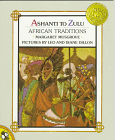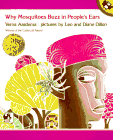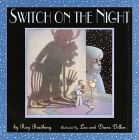
|
L
E O
& D
I A N E
D
I L L O N : The Third Artist Rules
(excerpted from Locus Magazine, April 2000)
Interview |
Gallery #1 |
Gallery #2: Ace Specials
| ||
 Photo by Beth Gwinn |
Leo Dillon (Lionel John Dillon, Jr.) and Diane Dillon (née Diane Claire Sorber) were born 11 days apart in March 1933, on opposite coasts. He grew up in Brooklyn, she was born and raised in California, and they met in 1953 while attending Parsons School of Design in New York City. They married in 1957. Son Lee (Lionel John Dillon III), born in 1965, also became an artist; in the '90s, he collaborated with them on several projects, including the illustrations for Pish, Posh, Said Hieronymous Bosch by Nancy Willard (1991). They met Harlan Ellison in 1959, after doing illustrations for Rogue, the men's magazine he was then editing in Chicago. That meeting would eventually have major consequences for the field of SF and fantasy art, thanks to their illustrations for |
|
§ Amazon links:
§
Search Amazon.com for § § |
Dangerous Visions (1967) and a subsequent meeting with Terry Carr, who recruited them as cover artists for the Ace Specials in the '60s and '70s. It was mainly that work for Ace which earned them their 1971 Hugo for SF art.
Other notable SF and fantasy books featuring their artwork include Joan D. Vinge's The Snow Queen (1979), Ray Bradbury's The Halloween Tree (1988), and many of C.S. Lewis's ''Narnia'' books in 1994. The Dillons won back-to-back Caldecott medals for children's book illustration, with Why Mosquitoes Buzz in People's Ears (1976) and Ashanti to Zulu (1977). A major collection of their work is The Art of Leo & Diane Dillon, edited by Byron Preiss (1981). Interview conducted by Karen Haber.
Leo: ''I'm constantly surprised at how our work is melding more and more as the years go on. In the beginning it was a conceived plan for us to work in a particular style which we both could master. So in reality we were both working for 'someone else': the style. Forty years ago there were techniques neither one of us would attempt, and somewhere along the line, one picked it up and the other followed, and back and forth. For us to be able to collaborate is somewhat of an amazing thing.''
Diane: ''At the point we hit the 'Third Artist' concept, it helped us a lot, because we could look at ourselves as one artist rather than two individuals, and that third artist was doing something neither one of us would do. That lifted the work away from reflecting either one's personal viewpoint. We let it flow the way it flows when an artist is working by themselves and a color goes down that they didn't quite expect and that affects the next colors they use, and it seems to have a life of its own.
''The same as writers who talk about how these characters take over their work. In a sense that happens in the creative process with us, too. We're able to accept that flow. If a piece takes on a certain look when I'm doing it, and I hand it to Leo, it flows into something else, and he goes right along with it. Then when it comes back to me I pick it up from that point and carry it on.''
Leo: ''People often comment on the 'Dillon style.' I think that someplace, the two of us made a pact with each other. We both decided that we would give up the essence of ourselves, that part that made the art each of us did our own. And I think that in doing that we opened the door to everything.”
*
Diane: ''We've never specialized. At the very beginning we had trouble with that. Art directors kept telling us we had too many styles in our portfolio and that they needed to know a specific style so they could remember us. We even split our portfolio up into three portfolios just so we could simplify. And at one point, very early on, we called ourselves 'Studio Two.' We thought that would be more acceptable with so many styles.
''Despite our refusal to specialize with technique or style, it's interesting that even when we thought we were doing things that people would never recognize, people would say, 'Oh, did you do such and such? It looks like your work.'''
Leo: ''Yes, that always shocked me. I could never figure that one out.''
Diane: ''Even I was fooled once. I went to pick up a job, and the art director said he had a sample of the style in which he wanted this piece, and he handed me the sample. I came home, furious, and said to Leo, 'There's somebody out there that's copying us, line for line. Look at this!' And Leo said, 'Don't you remember, we did that?'''
Leo: ''I remember an art director once telling me about what he wanted for a project, and I said, 'Great, so this is the illustration you want?' and he said, 'If I wanted an illustration, I wouldn't call on you two.' [chuckles] And that insulted the hell out of me. What a statement to make. We are illustrators.
''Now I understand what he meant. He didn't want what passed at the time for a style of illustration. He wanted something different. We're not photographic artists. We blend flat design and rendering. Some people have described our work as decorative realism.''
Diane: ''We take great pride in illustration and the fact that we are illustrators. We've never thought there is a difference between 'fine' art and illustration other than good art or bad art. One publisher once complemented us by saying that they were going to give us credit on the book jacket as 'paintings by the Dillons,' rather than illustrations. We said, 'No, we want illustrations.' That's what we are, that's what we do, and we're very proud of it. If it's good, so much the better that it should be called an illustration.”
*
Leo: ''One of the things we're not pursuing is digital art, and I've had a number of thoughts on this. One, with the advent of the camera, artists gave up a particular strength they had to observe first-hand and to put down. Too often, the photographed image comes between that prime observance. So you're really looking at a photograph and redrawing that. I think photographs heavily influenced the way artists view life.
''Now, we look at the computer, which comes along and says: 'You didn't have to observe, and you could get away with it. Now you don't even have to paint and you can get away with it.' And we have drawn the line there. We feel that we will give away no more part of ourselves than we have with the camera, and try to retain that eye-to-mind-to-hand thing.''
Diane: ''Computer art is so much image and too much color at this point. I think in time, once the newness wears off, that people might find their own personal image or voice, and not try to put in everything they can, plus the kitchen sink.''
Leo: ''It's cold.''
Diane: ''It doesn't have the mistakes and the blotches, the brushstrokes. The layers of complexity that can build up.''
Leo: ''The feeling. It lacks feeling.''
Diane: ''Maybe the next generation of fantastic computer art will warm up.''
*
Diane: ''We're not natural travelers. It's disruptive. And we're not performers. It takes planning to get up and go and be on stage. It's always an effort for us. When we're out we do have a very good time. It's always very heart-warming to see that people have been collecting our work and that they know more about it than we do, sometimes. It's like soul food. It's a nice thing to happen and we appreciate it when we're out there, but we like to stay in our house. In fact, that's one reason why Harlan came to visit us.''
Leo: ''And that's how we met Terry Carr, too. Harlan Ellison edited Dangerous Visions - and I don't know if too many people know about this, but there were not supposed to be illustrations in that book. Harlan, with the power of only Harlan, said 'I want illustrations.' And the publisher said, 'Okay, if you can do it over the weekend, you can have it. We're going to press on Monday, and if you don't have any drawings, that's it.' They thought they had him. [laughs]. So Harlan called us and said, 'There's this impossible task. I want each story illustrated. We've only got two days to do it.' That's Harlan. We had gone down some very odd roads with him already. [laughs] So we said, 'Well, yeah, we can try. Come on over.'''
Diane: ''We were so hungry in those days too. We were still taking whatever we could get.''
Leo: ''Not that there was much money involved at that time, but we were promised a royalty. [laughs] So Harlan came over, and brought Terry Carr, whom we had never met before. And boy, we hit it off, with both Terry and his wife, Carol.
''What Harlan did, in order to speed up the process, was to write a synopsis of each story and give us the kind of in-between-the-lines meaning so that we would be able to get the essence of the stories. Because we didn't have time to read all of them, he just kept turning these things out, and we kept drawing.''
Diane: ''It was like a factory. We didn't go to sleep. We were all up for most of the weekend. And we got it done.''
Leo: ''Yes. On Monday morning, Harlan marched over to the publisher, illustrations in hand.''
Diane: ''After that, Terry began giving us assignments for book jackets, the Ace Specials. I don't think when it started we realized there were going to be that many. A whole series. Maybe even he didn't know.''
Leo: ''He said we could do them any way we wanted. That was Terry: pure freedom. He said 'You can design the logo, you can do anything, anything that you want to do.'''
Diane: ''We had done science fiction before this, for the art editor W.I. Van Der Poel at Galaxy.''
Leo: ''We had really begun to get into experimenting with different techniques and looks. So along comes this chance to do what we had always wanted to do, to take science fiction out of that spaceship-and-craters-on-the-planet look. And here was Terry, who said, 'Go ahead. Try it. Try it.' It was really just perfect for us.'' |
| © 2000 by Locus Publications. All rights reserved. |



